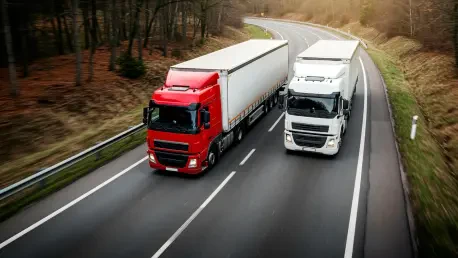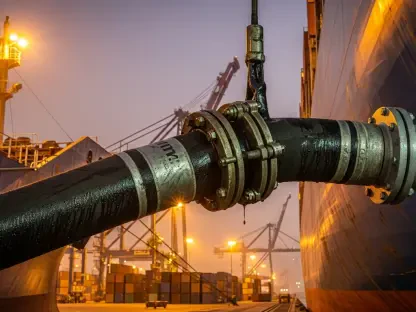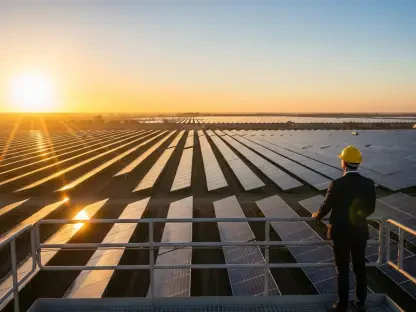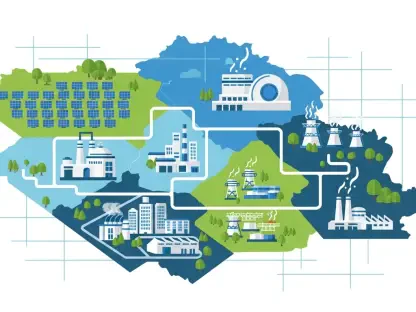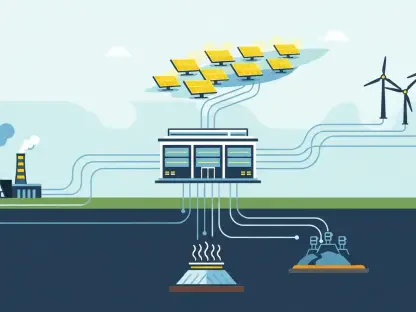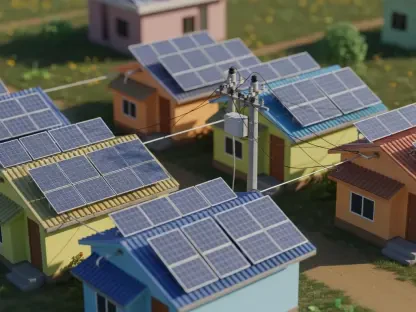Overview of Sustainable Transportation in Trucking
The trucking industry stands at a critical juncture, grappling with the urgent need to slash greenhouse gas emissions while maintaining the power and reliability demanded by long-haul operations. Imagine a fleet manager facing skyrocketing fuel costs and tightening regulations, forced to choose between untested electric vehicles (EVs) and alternative fuels that promise diesel-like performance. This scenario encapsulates the broader challenge of sustainable transportation, where environmental imperatives collide with operational realities in a sector responsible for moving vast quantities of goods across continents.
At present, the push toward greener fuels in trucking is not merely a trend but a necessity, driven by the sector’s significant environmental footprint. Heavy-duty vehicles contribute a substantial share of transportation-related emissions, prompting stakeholders to seek alternatives to traditional diesel. The industry, valued at billions annually, faces mounting pressure to adopt solutions that balance ecological impact with economic viability, making the transition to sustainable fuels a top priority for manufacturers and fleet operators alike.
Key players like Cummins are at the forefront of this transformation, pioneering technologies such as the X15N 15-liter natural gas engine, while EV manufacturers continue to innovate with zero-emission solutions. The scope of this shift is immense, encompassing market dynamics, regulatory frameworks, and technological advancements. With global calls for reduced emissions intensifying, the trucking sector must navigate a complex landscape to align with sustainability goals without sacrificing performance or profitability.
Comparing Powerhouses: Natural Gas Engines vs. EVs
Technological Trends and Innovations
The drive for sustainable trucking solutions has spurred a wave of innovation, with alternative fuels gaining traction alongside electric powertrains. Natural gas engines, such as Cummins’ X15N, represent a significant leap forward, offering up to 500 horsepower and a 10% improvement in fuel economy compared to diesel counterparts. This technology bridges the gap between environmental responsibility and the high-performance needs of heavy-duty applications, positioning it as a viable contender in the market.
In parallel, EV advancements are reshaping consumer perceptions, fueled by zero-emission capabilities and growing government support. Market drivers, including corporate sustainability mandates, are accelerating adoption, though challenges persist in scaling these solutions for long-haul routes. Battery technology continues to evolve, promising greater range and faster charging, yet the pace of infrastructure development often lags behind these technological strides.
Natural gas, meanwhile, benefits from existing infrastructure, with over 300,000 miles of interstate and intrastate pipelines in the U.S. facilitating its integration into trucking fleets. This availability creates new opportunities, particularly for heavy-duty applications where refueling convenience is paramount. As both technologies vie for dominance, their respective innovations highlight a broader trend of diversification in sustainable transportation solutions.
Market Performance and Growth Forecasts
Current market data reveals a fragmented landscape, with EVs holding a growing but still modest share of the trucking sector, primarily in urban and regional applications. Natural gas engines, though less prominent in passenger vehicles, are carving out a niche in heavy-duty markets, bolstered by their compatibility with existing logistics networks. Industry reports suggest that while EVs dominate headlines, natural gas solutions are quietly gaining ground among fleet operators prioritizing cost and range.
Looking ahead, growth projections paint an optimistic picture for natural gas engines, with experts forecasting a potential 20% market penetration in the coming years. This trajectory hinges on continued investments in refueling infrastructure and technological refinements. Performance metrics further underscore the appeal of natural gas, with competitive operational costs and efficiency gains compared to diesel, while EVs struggle with higher upfront expenses despite long-term savings.
A forward-looking analysis suggests that both technologies will evolve in tandem with infrastructure enhancements. For natural gas, leveraging established pipelines could accelerate adoption, while EVs depend on the rapid expansion of charging networks. Market evolution will likely favor a hybrid approach, where each solution addresses specific needs within the diverse trucking ecosystem, driven by targeted investments and strategic partnerships.
Challenges in Adopting Sustainable Trucking Solutions
The path to sustainable trucking is fraught with hurdles, particularly for EVs, where high initial costs deter widespread adoption. Fleet operators often balk at the price tag of electric trucks, compounded by limited charging infrastructure that restricts their utility for long-haul routes. Additionally, the reduced driving range compared to diesel or natural gas options poses logistical challenges, requiring careful route planning and downtime for recharging.
Natural gas engines, while more accessible in terms of refueling, are not without issues. Despite operating 90% below current EPA emission standards, they still emit some greenhouse gases due to their combustion-based design, limiting their appeal as a fully green solution. This residual environmental impact raises questions about their long-term viability in a world increasingly focused on zero-emission targets, even as they offer a pragmatic interim step.
Broader market and technological barriers also impede progress, including consumer hesitation rooted in unfamiliarity with alternative fuels and the pressing need for expanded refueling networks. Overcoming these obstacles may involve leveraging existing natural gas infrastructure to build confidence and accessibility. Collaborative efforts between industry and policymakers could further address these gaps, ensuring that both EVs and natural gas engines find their place in a transitioning market.
Regulatory Landscape for Green Trucking Technologies
Government regulations play a pivotal role in shaping the adoption of sustainable trucking technologies, with EPA emission guidelines setting stringent benchmarks for manufacturers. These standards compel the industry to innovate, pushing both EV and natural gas solutions to meet increasingly rigorous environmental criteria. Compliance is not just a legal obligation but a competitive differentiator, influencing fleet decisions and operational strategies.
Incentives for EVs, such as tax credits and subsidies, have bolstered their market presence, encouraging investment in zero-emission fleets. Conversely, policy support for natural gas as an alternative fuel remains less pronounced, though advocacy for its inclusion in green initiatives is growing. Such measures could level the playing field, recognizing natural gas as a transitional technology with immediate benefits for emission reductions.
The regulatory environment is dynamic, with potential shifts poised to alter the competitive balance between these technologies. Stricter mandates or expanded incentives could accelerate EV adoption, while recognition of natural gas as a bridge fuel might spur infrastructure development. Fleet operators must stay attuned to these changes, adapting their strategies to align with evolving compliance demands and capitalize on available support mechanisms.
Future Outlook for Trucking’s Sustainable Fuels
The horizon for sustainable trucking appears multifaceted, with both EVs and natural gas engines carving out distinct roles based on operational needs. EVs are likely to dominate shorter, urban routes where charging infrastructure can keep pace, while natural gas may hold sway in long-haul applications requiring robust power and range. This segmentation reflects the diverse demands of the industry, suggesting coexistence rather than a clear winner.
Potential disruptors loom large, including breakthroughs in battery technology that could extend EV range or innovations in renewable natural gas production that enhance its environmental credentials. Infrastructure expansion, particularly for natural gas, could further tilt the scales, capitalizing on existing pipelines to support broader adoption. These developments will shape how each technology addresses the core needs of trucking fleets over the next several years.
Consumer preferences are also evolving, with power and range remaining paramount for long-haul operators. As innovation accelerates, global economic conditions and regulatory shifts will influence market growth, potentially favoring solutions that balance cost with sustainability. The interplay of these factors underscores the importance of flexibility in strategic planning, ensuring the industry remains responsive to emerging opportunities and challenges.
Conclusion: A Diverse Path to Sustainable Trucking
Reflecting on the insights gathered, it becomes evident that natural gas engines like Cummins’ X15N offer substantial strengths in power and efficiency, while EVs excel in zero-emission applications despite infrastructure constraints. The analysis highlights the complementary potential of these technologies, each addressing unique facets of trucking demands, from long-haul endurance to urban delivery needs.
Moving forward, stakeholders are encouraged to prioritize investments in dual infrastructures, supporting both charging networks for EVs and refueling stations for natural gas. Collaborative efforts between manufacturers, policymakers, and fleet operators emerge as critical to overcoming adoption barriers. A balanced approach, blending technological innovation with policy advocacy, is seen as the most effective way to advance global sustainability goals in trucking.
